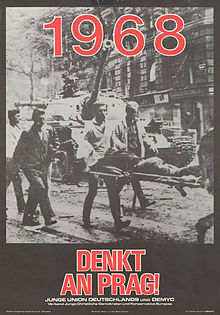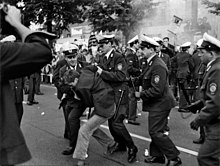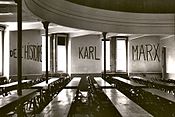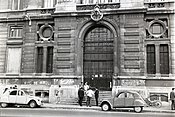Protests of 1968
| Protests of 1968 | |
|---|---|
| Part of the Counterculture of the 1960s and the Cold War | |
 Demonstrations against the Vietnam War in Amsterdam, 1968 | |
| Date | 5 January 1968 – 29 March 1969 (1 year, 2 months, 3 weeks and 3 days) |
| Location | Worldwide |
| Caused by | |
| Goals | |
| Resulted in | Social revolutions |
The protests of 1968 comprised a worldwide escalation of social conflicts, which were predominantly characterized by the rise of left-wing[1] politics, anti-war sentiment, civil rights urgency, youth counterculture within the silent and baby boomer generations, and popular rebellions against state militaries and bureaucracies.
In the United States, the protests marked a turning point for the
The most prominent manifestation was the
In the countries of Eastern Europe under communist parties, there were protests against lack of freedom of speech and violation of other civil rights by the communist bureaucratic and military elites. In Central and Eastern Europe, there were widespread protests that escalated, particularly in the Prague Spring in Czechoslovakia, in Warsaw, Poland, and in Yugoslavia.
Background
Multiple factors created the protests in 1968. Many were in response to perceived injustice by governments—in the USA, against the Johnson administration—and were in opposition to the draft, and the United States' involvement in the Vietnam War.
Post-war world

After
The Cuban Missile Crisis and the Cold War was another shared experience of this generation. The knowledge that a nuclear attack could end their life at any moment was reinforced with classroom "duck and cover" bomb drills[5] creating an omnipresent atmosphere of fear. As they became older, the anti-war, civil rights, peace, and feminist movement for women's equality were becoming forces in much of the world.
Social movements

The
Waves of
The women's liberation movement caused generations of females to question the global status quo of unequal empowerment of women, and the post-war baby boomer generation came to reassess and redefine their priorities about marriage and motherhood. The peace movement made them question authority more than ever before.[6] By the time they started college, the majority of young people identified with an anti-establishment culture, which became the impetus for the wave of rebellion and re-imagination that swept through campuses and throughout the world. College students of 1968 embraced progressive, liberal politics. Their progressive leanings and skepticism of authority were a significant impetus to the global protests of 1968.
Dramatic events of the year in the Soviet Bloc revealed that the
In 1968, Czechoslovakia underwent a process known as the Prague Spring. In the August 1968
On 25 August 1968 eight Russian citizens staged a demonstration on Moscow's Red Square to protest the Soviet invasion of Czechoslovakia. After about five minutes, the demonstrators were beaten up and transferred to a police station. Seven of them received harsh sentences up to several years in prison.
Protests
This section needs expansion. You can help by adding to it. (August 2016) |

The protests that raged throughout 1968 included a large number of workers, students, and poor people facing increasingly violent state repression all around the world. Liberation from state repression itself was the most common current in all protests listed below. These refracted into a variety of social causes that reverberated with each other: in the United States alone, for example, protests for
As the waves of protests of the 1960s intensified to a new high in 1968,
Mass movements

The environmental movement can trace its beginnings back to the protests of 1968. The environmental movement evolved from the anti-nuclear movement. France was particularly involved in environmental concerns. In 1968, the French Federation of Nature Protection Societies and the French branch of
In January, police used clubs on 400 anti-war/anti-Vietnam protesters outside of a dinner for U.S. Secretary of State Rusk.
Brazil
On March 28, the Military Police of Brazil killed high school student Edson Luís de Lima Souto at a protest for cheaper meals at a restaurant for low-income students. The aftermath of his death generated one of the first major protests against the military dictatorship in Brazil and incited a national wave of anti-dictatorship student demonstrations throughout the year.
Czechoslovakia and the Soviet Union

In what became known as
France
The French May protests started with student protests over university reform and escalated into a month-long protest. The trade unions joined the protest resulting in a general strike.[citation needed]
Italy
On March 1, a clash known as the
Japan

Protests in Japan, organized by socialist student group Zengakuren, were held against the Vietnam War starting January 17, coinciding with the visit of the USS Enterprise to Sasebo.[20] In May, violent student protests erupted at multiple Japanese universities, having started earlier in the year from disputes between faculty and students for more student rights and lower tuition fees. Students occupied buildings and clashed with staff, holding "trials" in public.[21]
Mexico

Mexican university students mobilized to protest Mexican government
Pakistan
In November 1968, mass student movement erupted in Pakistan against the military dictatorship of
Poland
On January 30, 300 student protesters from the
South Africa

In South Africa, the (white-only) University of Cape Town (UCT) Council's decision to rescind Archie Mafeje's (black) offer for a senior lecturer position due to pressure from the Apartheid government has angered students and led to protests on 15 August 1968 followed by a nine days sit-in at UCT administration building. Protesters faced intimidation from the government, anti-protestors and fellow Afrikaans students from other universities. The police swiftly squashed support for the sit-in. In the aftermath, Mafeje left the country and did not return until 2000.[30]
Spain
Compared to other countries, the repercussions of 1968 were much smaller in Spain, mostly being protests and strikes repressed by Franco's regime. Workers were joined by students at the
Sweden

On May 3 activists protested the participation of two apartheid nations, Rhodesia and South Africa's, in the international tennis competition held in Båstad, Sweden. The protest was among the most violent between Swedish police and demonstrators during the 1960s, resulting in a dialogue between the Swedish Government and organizers to curb the escalation of violence. The match was later played in secrecy, with Sweden winning 4-1.[33]
At Stockholm University leftist students occupied their Student Union Building at Holländargatan from May 24–27 to send a political message to the government. Inspired by the protests in France earlier that month, the Stockholm protests were calmer than those in Paris.[34] In reaction to the protests, right-wing students organized Borgerliga Studenter, or "Bourgeois Students", whose leaders included future prime ministers Carl Bildt and Fredrik Reinfeldt. The Student Union building would later be absorbed by the Stockholm School of Economics.
Tunisia
In Tunisia, a wave of student-led demonstrations and street protests in front of campuses began in March in inspiration of protests in Poland and the 1968 protests in Egypt. Student protests, however, were quelled by police and the movement was crushed; in the short-lived period there were peaceful protests and demonstrations for one week.
United Kingdom
A series of art school occupations quickly spread throughout the UK during May and July 1968. The occupation at Hornsey College of Art (now Middlesex University) remains an emblematic event in the modern history of British universities. Cambridge students were involved in the Garden House riot on 13 February 1970.
Northern Ireland
On 24 August 1968, the Northern Ireland civil rights movement held its first civil rights march, from Coalisland to Dungannon. Many more marches were held over the following year. Loyalists (especially members of the UPV) attacked some of the marches and held counter-demonstrations in a bid to get the marches banned.[35] Because of the lack of police reaction to the attacks, nationalists saw the RUC, almost wholly Protestant, as backing the loyalists and allowing the attacks to occur.[36] On 5 October 1968, a civil rights march in Derry was banned by the Northern Ireland government.[37] When marchers defied the ban, RUC officers surrounded the marchers and beat them indiscriminately and without provocation. More than 100 people were injured, including a number of nationalist politicians.[37] The incident was filmed by television news crews and shown around the world.[38] It caused outrage among Catholics and nationalists, sparking two days of rioting in Derry between nationalists and the RUC.[37] A few days later, a student civil rights group – People's Democracy – was formed in Belfast.[35] In late November, O'Neill promised the civil rights movement some concessions, but these were seen as too little by nationalists and too much by loyalists.
These protests started turning violent, and a year later, the
United States
In the United States, the
West Germany

The
Yugoslavia
Other protests
In October, the
See also
- 1967 Long Hot Summer
- 1968 Democratic National Convention protest activity
- 1968 Miami riot
- 1968 uprising in Senegal (occurred in same year)
- 1969 Cordobazo (which occurred the next year in Argentina)
- 1969 Hot Autumn (which occurred the next year in Italy)
- A Grin Without a Cat
- American Power and the New Mandarins, book by Noam Chomsky
- Assassination of Fred Hampton
- Axel Springer AG
- Carlos Marighella
- Catonsville Nine
- Chicago Seven
- Civil Rights Act of 1968
- Counterculture of the 1960s
- Days of Rage
- Feminism in France
- Fluxus
- Give Peace a Chance
- Glenville Shootout
- Happening
- Hippies
- Arab Spring
- May 4 massacre
- Revolutions of 1848
- Revolutions of 1917–1923
- Revolutions of 1989
- Rudi Dutschke
- Situationist International
- Stonewall riots (which occurred the next year)
- Summer of love
- List of incidents of civil unrest in the United States
- Yippies
Citations
- ^ "A look back at the 1968 Democratic National Convention". MSNBC.com. 2014-08-28. Retrieved 2023-10-06.
- ^ Twenge, Ph. D., Jean. Generation Me. New York: Free Press, 2006. p. 6
- ^ Croker 2007 p. 19
- ^ Croker 2007 p. 12
- ^ Croker 2007 p. 32
- ^ Croker 2007 p. 124
- ^ "Belgrade's 1968 student unrest spurs nostalgia". Thaindian.com. 2008-06-05. Archived from the original on 2016-12-30. Retrieved 2010-08-26.
- ^ 1968 in Europe - Online teaching and research guide, archived from the original
- ^ a b Rootes, Christopher. "1968 and the Environmental Movement in Europe" (PDF). [permanent dead link]. Retrieved 02-2008.
- ^ a b c Sean O'Hagan (January 19, 2008). "Everyone to the Barricades". The Observer. Retrieved 2008-02-18.
- ^ Kurlansky 2004 p. 42
- ^ a b Kurlansky 2004 p. 54
- ^ Kurlansky 2004 p. 55
- ^ a b Surak, Amy. 1968 Timeline. New York University Archives. Retrieved 02-2008.
- ^ "1968 battles outside US Embassy, Grosvenor Square, London | 1968 and All That". Archived from the original on 2008-01-29. Retrieved 2008-02-18. 1968 Battles outside US Embassy, Grosvenor Square, London. 1968 and All That. 15 January 2008. Retrieved 02-2008.
- ^ a b Kurlansky 2004 p. 84
- ^ Freeman, Jo. "No More Miss America! (1968–1969)" Retrieved 02-2008.
- ^ "Czechoslovakia, 1968 Prague Spring". The Library of Congress Country Study. Retrieved: 02-2008 [permanent dead link]
- ^ a b c Kurlansky 2004 p. 82
- ^ Marotti, William. "Japan 1968: The Performance of Violence and the Theater of Protest." The American Historical Review 114, no. 1 (2009): 97-135. Accessed September 1, 2020. http://www.jstor.org/stable/30223645.
- JSTOR 40649684.
- ^ Jesús Vargas Valdez, "Student Movement of 1968" in Encyclopedia of Mexico, Chicago: Fitzroy Dearborn 1997, pp. 1379-1382.
- ^ Erickson, Ric. "May '68 Dates." Metropole Paris. 4 May 1998. Retrieved 02-2008.
- ^ Ali, Tariq (2008-03-22). "Tariq Ali considers the legacy of the 1968 uprising, 40 years after the Vietnam war". The Guardian. Retrieved 2018-08-31.
- ^ Authors, Dawn Books And (2012-08-18). "REVIEW: Pakistan's Other Story: The Revolution of 1968-1969 by Lal Khan". DAWN.COM. Retrieved 2018-08-31.
- ^ Zabala, Santiago. "What the May 1968 revolts did and did not do". www.aljazeera.com. Retrieved 2018-08-31.
- ^ InpaperMagazine, From (2014-08-31). "Exit stage left: the movement against Ayub Khan". DAWN.COM. Retrieved 2018-08-31.
- ^ 1968: The Year of the Barricades. The History Guide. Retrieved 02-2008 ARCHIVE
- ^ Kurlansky 2004 p. 127
- S2CID 145251370.
- ^ Kurlansky 2004 p. 16
- Olof Palme - En levande vilja: Tal och intervjuer
- ^ Wijk, Johnny (2009-03-07). "Idrotten tjänar på de politiska aktionerna". Dagens Nyheter (in Swedish). Retrieved 2012-06-26.
- ^ Claes Fredelius: Kårhusockupationen. From the book Det är rätt att göra uppror – Om klasskampen i Sverige. Stockholm 1970, Bonniers.
- ^ a b Chronology of the Conflict: 1968, cain.ulst.ac.uk. Retrieved 12 June 2013.
- ^ "Submission to the Independent Commission into Policing". Serve.com. Archived from the original on 22 November 2008. Retrieved 2 November 2008.
- ^ a b c Martin Melaugh. "The Derry March: Main events of the day". Conflict Archive on the Internet (CAIN). Retrieved 16 February 2008.
- ISBN 0856403237.
- ^ Black Power. African American World. Retrieved 02-2008.
- ^ "The Orangeburg Massacre". Archived from the original on 2007-03-10. Retrieved 2007-03-10. The Orangeburg Massacre. Ask.com About African-American History. Retrieved 02-2008.
- ^ Kurlansky 2004 p. 85
- ^ Inda, Juan Javier La Comunidad en Lucha, The Development of the East Los Angeles Student Walkouts Working Paper, Stanford University (1990)
- ^ Walsh, Michael. "Streets of Fire: Governor Spiro Agnew and the Baltimore City Riots, April 1968." "Governor Spiro Agnew and the Baltimore Race Riots of April 1968". Archived from the original on 2008-07-26. Retrieved 2008-02-18.. Retrieved 02-2008.
- ^ "1968 in Europe - Online Teaching and Research Guide". Archived from the original on 2008-05-11. Retrieved 2008-04-28. Klimke, Dr. Martin. 1968 in Europe. Online Teaching and Resource Guide. Retrieved 02-2008.
General references
- Croker, Richard (2007), The Boomer Century, New York: Springboard Press
- Kurlansky, Mark (2004), 1968: The Year That Rocked the World, New York: Random House Publishing Group
External links
- 1968 in Europe
- 1968 in Italy
- NPR Echoes of 1968
- BBC Radio 4 - 1968: Myth or Reality?
- 1968 Special Report, The Guardian
- Everyone to the Barricades - Europe 1968—Sean O'Hagen, The Guardian
- Timeline of 1968, International Socialism, Spring 2008
- 1968 In Italy: Revolution or Cold Civil War
- European protestmusic in 1968 - the birth of European identities in music
- De 1968 au mouvement Occupy,Mappingthepresent.org Archived 2018-07-15 at the Wayback Machine
- An archive containing photographs of 1968/1969 protests in the San Francisco area



